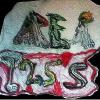first of all , thank you for the awesome information addx !!
i ve been researching and experimenting to find information on how to cure my complete anehdonia, almost a year has gone by, and after reading a lot, and trying tons of supplements, your theory makes total sence , it seems to realy be one important part to the issue. also your theory correlates 100% with all my personal experience.
Still one thing about kor antagonism concerns me. It may be that after antagonism kor doesn't get upregulated directly BUT what about it beeing upregulated indirectly ? wich is very likely, since the body always counteracts such actions.
I 've read a lot of papers wich show A FEW of the reactions the body has on kor antagosims. Of corse no one can make a prediction what the long term consecuenses due to kor antagonism can be, i think its just way too complex.
just out of curiosity, couldn'T it be that maybe after kor antagonism, the body has prepared in such way that the next time something happens that activates the kor system, this system responds to greater degree then previous to kor antagonism, reaching previous kor peak much faster and also expanding its degree.
i bet there are no studies on this, BUT "the absence of evidence is not the evidence of absence".
I'm concerned of whether kor agonism is the safer option.
Nevertheless i am going to give it a try since i dont have anything else left.
i wanted to try buprenorphine + naltrexone/subuxone. but since i cannot find bupre and naloxone on the pharmacies wich are recommended here in longecity, and also i dont realy like the agonism of the other opioids.
So think i will just go with naltrexone. in addition i will drink some cacao and take green tee extract, since the catechins may also have kor antagonism properties.
also my system does not produce any endorphins, not even during sports, quite the opossite, when i do joggin after 30 minutes where the endorphins are supposed to start getting produced my head starts getting energy drained, fatigued and i usualy start getting headaches, resulting later the day in complete mental fatigue. so even if naltrexone just helps with endorphines i would be realy happy.
so i have just one question about the naltrexone dosage, which is too specific i guess, since i want it for kor antagonism.
is low dose naltrexone effective for kor antagonism or should i just try to work my way up to standart dosage for good kor antagonism ?
i ve searched for this but there is no specific answer to kor antagonism dosage.
if someone knows a reliable pharmacy for buprenorphine, i would be very thankfull, combining it with naltrexone should be very effective, eventhough i have to rethink it if i use this combo due to opiod agonism.
i am going to post the results here if they are positive, or even negative ?.
Edited by chris7900, 30 June 2014 - 06:11 PM.


















































